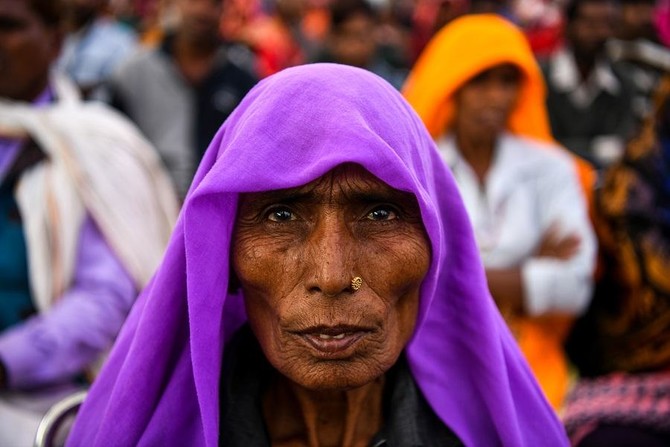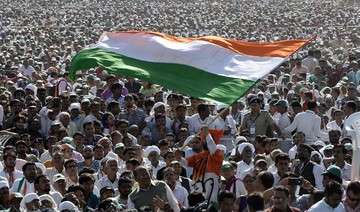NEW DELHI: Rising property prices in parts of India have helped achieve what women’s rights groups have tried and failed to do for decades — get more women to claim their inheritance.
A 2005 law gave Hindu women across India equal inheritance rights but few have made claims because they are unaware of the law, or have been forced to give up their claims by male family members, according to analysts.
But an increase in property prices near the Indian capital, New Delhi, has pushed more women in Haryana state to claim their share, gender and land rights experts said on Wednesday.
“Despite laws that give rights of inheritance to women, low levels of education and a strong patriarchal tradition can rob women of these rights,” said Prem Chowdhry, a gender expert who has researched women’s inheritance in Haryana.
“But because prices of land have sky-rocketed in these areas, women are being pushed by their husbands or fathers-in-law to claim their share of the family property, or at least be compensated in some way for it,” she said on the sidelines of a land conference in New Delhi.
Property prices in the three Haryana cities that are closest to Delhi have risen by more than half in the past decade as more migrants flocked to the capital and transport links improved, according to Anarock, an Indian property consultant.
Amendments in 2005 to the Hindu Succession Act, which governs matters of inheritance among Hindus — who make up about 80 percent of India’s population — made women’s inheritance rights equal to those of men.
Yet in several states in northern and western India, the custom of “haq tyag,” or sacrifice of right, is practiced, where a woman relinquishes her claim on ancestral property.
The tradition is justified on the grounds that the father pays for his daughter’s wedding and often also gives a dowry, and therefore only the sons are entitled to the family property.
While haq tyag is voluntary, women come under enormous pressure to comply to maintain their relations with their families, Chowdhry told the Thomson Reuters Foundation.
Although there is no official data on inheritance claims made by women in India, only 13 percent of farmland is owned by women, according to the latest census data from 2011.
In a bid to address the imbalance, several states including Haryana — which has among the worst gender imbalances in the country — have lowered registration charges and taxes when a property is in the name of a woman.
These changes have done little to improve women’s property ownership rates, said Govind Kelkar, a senior adviser to the global land rights advocacy group Landesa.
While agreeing that rising property prices could push more women to claim their inheritance, Kelkar said women still had little control over the property they inherited.
“There can also be an increase in violence against women,” she said. “The patriarchal tradition is so strong that women, who themselves own property, when asked if they will leave it to their daughter, still say no.”
As property prices rise, more Indian women claim inheritance
As property prices rise, more Indian women claim inheritance

- An increase in property prices near New Delhi has pushed more women in to claim their share
- Only 13 percent of farmland is owned by women, according to the latest census data from 2011
Materials sector dominates TASI trading in first quarter of 2024

- Saudi Aramco topped the list with a market capitalization of SR7.47 trillion: report
RIYADH: The materials sector led trading on Saudi Arabia’s Tadawul All Share Index, accounting for approximately SR87 billion ($23.2 billion) or 15.11 percent of the market, according to TASI’s 2024 first-quarter report.
SABIC, the largest component of this sector, boasted a market capitalization of SR234.9 billion, with trading value reaching nearly SR7 billion.
The banking sector trailed with transactions valued at SR71.22 billion, comprising 12.37 percent of the market. Al-Rajhi Bank took the lead in market capitalization within the sector and secured the second spot in trade value totaling SR23.62 billion.
In a February report by Bloomberg, Al-Rajhi Bank, seen as an indicator of Saudi Arabia’s growth strategies, exceeded the performance of JPMorgan Chase & Co., exhibiting nearly a 270 percent surge in shares since the initiation of Vision 2030. It has outpaced both local and global competitors, including state-supported banks, emerging as the largest bank in the Middle East and Africa, boasting a market cap of around $95 billion.
According to Morgan Stanley analysts led by Nida Iqbal, as reported by Bloomberg, “We see it as a long-term winner in the Saudi bank sector … While Al-Rajhi is best placed for a rate-cutting cycle, we believe current valuation levels reflect this.”
Gulf central banks, including Saudi Arabia’s, frequently align their policies with those of the Federal Reserve to maintain their currency pegs to the dollar. According to Bloomberg Intelligence senior analyst Edmond Christou, a reduction in Fed rates could potentially bolster Al-Rajhi Bank’s profitability and expansion, as it will encourage gathering cheap deposits while enabling it to issue debt at more attractive levels.
In this period, the energy sector secured the third position in terms of value traded, reaching SR55.4 billion. Saudi Aramco topped the list with a market capitalization of SR7.47 trillion and registered the highest value among companies traded on the index, totaling SR28.82 billion.
In March of this year, Aramco announced a net income of $121.3 billion for its full-year 2023 financial results, marking the second-highest in its history. Aramco credited these results to its operational flexibility, reliability, and cost-effective production base, underscoring its dedication to delivering value to shareholders.
Tadawul’s quarterly report also indicated that the transportation sector recorded the fourth-highest value traded at SR39.25 billion, equivalent to 6.82 percent of the market. Among the top performers in this sector was cargo firm SAL Saudi Logistics Services, ranking third in value traded on the TASI during this period, following Aramco and Al-Rajhi Bank, with a total value of SR22.74 billion.
SAL debuted on the main market of the Saudi Exchange in November last year. With aspirations to manage 4.5 million tonnes of air cargo by 2030, Saudi Arabia is empowering its logistics sector from a supportive role to a pivotal driver of economic growth.
SAL, in which the Saudi government holds a 49 percent stake through the Saudi Arabian Airlines Corp., experienced a 30 percent surge in its share price during its initial public offering, raising $678 million and becoming Saudi Arabia’s second-largest IPO of the year.
In a January report by Forbes, SAL’s CEO and Managing Director Faisal Al-Beddah emphasized the company’s potential to shape the future of logistics in Saudi Arabia and beyond. He stated: “Logistics is the backbone of any economy. Now we are ready. We have the rotation, we have the infrastructure, we have the regulations, and most importantly, we have the mindset and the technology for Saudi Arabia to be the leading connecting logistics hub in the region.”
The top gainer during this period in terms of price appreciation was MBC Group, with a quarter-to-date percentage change of 127.6 percent, according to Tadawul.
Saudi Arabia’s MBC Group, a media conglomerate, debuted as the first new listing on TASI in 2024. Its trading began on Jan. 8. The company raised SR831 million through its initial public offering.
Saudi Steel Pipes Co. in the materials sector was the second highest gainer, with price appreciating by 88.15 percent.
Etihad Atheeb Telecommunication Co. had a QTD price percentage change of 81.91
percent making it the third-highest gainer on the exchange during this period.
TASI concluded the first quarter of 2024 with a 3.6 percent increase, climbing by 435 points to reach 12,402 points.
Saudi banks’ funding profile changing on rising mortgage demand: S&P Global

RIYADH: Saudi banks are expected to pursue alternative funding strategies to deal with the rapid expansion in lending, fueled by the demand for new mortgages, according to S&P Global.
In its latest report, the credit-rating agency stated that the funding profiles of financial institutions in the Kingdom are set to undergo changes, primarily driven by a state-backed initiative to boost home ownership.
According to the analysis, mortgage financing represented 23.5 percent of Saudi banks’ total credit allocation at the end of 2023, compared to 12.8 percent in 2019.
“The ongoing financing needs of the Vision 2030 economic initiative and relatively sluggish deposits growth, is likely to incentivize banks to seek alternative sources of funding, including external funding,” said S&P Global.
The report also predicted that this pursuit of external funding could potentially impact the credit quality of Saudi Arabia’s banking sector.
According to the US-based rating agency, lending growth among Saudi banks has outpaced deposits, with the loan-to-deposit ratio exceeding 100 percent in 2022, up from 86 percent at the end of 2019.
S&P Global expects this trend to persist, particularly with corporate lending playing a more significant role in growth over the next few years. “We consider Saudi banks are likely to turn to alternative funding strategies to fund that expansion,” the report said.
HIGHLIGHTS
100%
According to the US-based rating agency, lending growth among Saudi banks has outpaced deposits, with the loan-to-deposit ratio exceeding 100 percent in 2022, up from 86 percent at the end of 2019.
It added: “We consider, however, that the risk created by the maturity mismatch is mitigated by the relative stability of Saudi deposits.” The agency also predicted that Saudi banks’ foreign liabilities will continue to increase, rising from about $19.2 billion at the end of 2023 to meet the funding requirements of strong lending growth, particularly amidst lower deposit expansion.
The report highlighted that Saudi banks have already tapped international capital markets, and the credit rating agency expects this trend to continue for the next three to five years.
According to S&P Global, the Saudi banking system could transition from a net external asset position of SR42.9 billion, or 1.6 percent of lending, at the end of 2023 to a net external debt position within a few years.
In April, S&P Global, in another report, stated that banks in the Kingdom are anticipated to experience robust credit growth ranging between 8 to 9 percent in 2024.
The agency noted that this credit expansion will be propelled by corporate lending, fueled by increased economic activities driven by the Vision 2030 program.
Moreover, the report added that the Saudi government and its related entities are expected to inject deposits into the banking system, thereby supporting the credit growth of financial institutions in the Kingdom.
NEOM, Saudi Red Sea Authority sign MoU to develop marine tourism regulations

- The MoU’s goal is to enhance research, deliver innovation, and improve the visitor experience for tourists
- The agreement reflects SRSA’s commitment to attracting investment in coastal tourism activities
NEOM: The Saudi Red Sea Authority and NEOM signed a memorandum of understanding on Friday to cooperate on developing legislation, regulations, and technology in marine tourism, reported the Saudi Press Agency.
The MoU’s goal is to enhance research, deliver innovation, and improve the visitor experience for tourists in Saudi Arabia’s existing, emerging, and future Red Sea coastal destinations.
SRSA Acting CEO Mohammed Al-Nasser and NEOM’s CEO Nadhmi Al-Nasr signed the partnership, which they hope will promote an exchange of expertise and enable the implementation of joint initiatives.
The agreement also reflects SRSA’s commitment to attracting investment in coastal tourism activities.
The partnership will further assist small and medium enterprises in the sector through administrative, technical, and advisory support.
Via this agreement, SRSA aims to integrate with relevant public, private, and third-sector entities to achieve one of the goals of Saudi Vision 2030, which is to develop coastal tourism as a valuable sector of the Kingdom’s economy.
World food prices up in April for second month: UN agency

PARIS: The UN food agency’s world price index rose for a second consecutive month in April as higher meat prices and small increases in vegetable oils and cereals outweighed declines in sugar and dairy products.
The Food and Agriculture Organization’s price index, which tracks the most globally traded food commodities, averaged 119.1 points in April, up from a revised 118.8 points for March, the agency said on Friday.
The FAO’s April reading was nonetheless 7.4 percent below the level a year earlier.
The indicator hit a three-year low in February as food prices continued to move back from a record peak in March 2022 at the start of Russia’s invasion of Ukraine.
In April, meat showed the strongest gain in prices, rising 1.6 percent from the prior month.
The FAO’s cereal index inched up to end a three-month decline, supported by stronger export prices for maize. Vegetable oil prices also ticked higher, extending previous gains to reach a 13-month high due to strength in sunflower and rapeseed oil.
The sugar index dropped sharply, shedding 4.4 percent from March to stand 14.7 percent below its year-earlier level amid improving global supply prospects.
Dairy prices edged down, ending a run of six consecutive monthly gains.
In separate cereal supply and demand data, the FAO nudged up its estimate of world cereal production in 2023/24 to 2.846 billion metric tonnes from 2.841 billion projected last month, up 1.2 percent from the previous year, notably due to updated figures for Myanmar and Pakistan.
For upcoming crops, the agency lowered its forecast for 2024 global wheat output to 791 million tonnes from 796 million last month, reflecting a larger drop in wheat planting in the EU than previously expected.
The revised 2024 wheat output outlook was nonetheless about 0.5 percent above the previous year’s level.
Material sector dominates TASI trading in first quarter of 2024

RIYADH: The materials sector led trading on Saudi Arabia’s Tadawul All Share Index, accounting for approximately SR87 billion ($23.2 billion) or 15.11 percent of the market, according to TASI’s 2024 first-quarter report.
SABIC, the largest component of this sector, boasted a market capitalization of SR234.9 billion, with trading value reaching nearly SR7 billion.
The banking sector trailed with transactions valued at SR71.22 billion, comprising 12.37 percent of the market. Al-Rajhi Bank took the lead in market capitalization within the sector and secured the second spot in trade value totaling SR23.62 billion.
In a February report by Bloomberg, Al-Rajhi Bank, seen as an indicator of Saudi Arabia’s growth strategies, exceeded the performance of JPMorgan Chase & Co., exhibiting nearly a 270 percent surge in shares since the initiation of Vision 2030. It has outpaced both local and global competitors, including state-supported banks, emerging as the largest bank in the Middle East and Africa, boasting a market cap of around $95 billion.
According to Morgan Stanley analysts led by Nida Iqbal, as reported by Bloomberg, “We see it as a long-term winner in the Saudi bank sector… While Al-Rajhi is best placed for a rate-cutting cycle, we believe current valuation levels reflect this.”
Gulf central banks, including Saudi Arabia’s, frequently align their policies with those of the Federal Reserve to maintain their currency pegs to the dollar. According to Bloomberg Intelligence senior analyst Edmond Christou, a reduction in Fed rates could potentially bolster Al-Rajhi Bank’s profitability and expansion, as it will encourage gathering cheap deposits while enabling it to issue debt at more attractive levels.
In this period, the energy sector secured the third position in terms of value traded, reaching SR55.4 billion. Saudi Aramco topped the list with a market capitalization of SR7.47 trillion and registered the highest value among companies traded on the index, totaling SR28.82 billion.
In March of this year, Aramco announced a net income of $121.3 billion for its full-year 2023 financial results, marking the second-highest in its history. Aramco credited these results to its operational flexibility, reliability, and cost-effective production base, underscoring its dedication to delivering value to shareholders.
Tadawul’s quarterly report also indicated that the transportation sector recorded the fourth-highest value traded at SR39.25 billion, equivalent to 6.82 percent of the market. Among the top performers in this sector was cargo firm SAL Saudi Logistics Services, ranking third in value traded on the TASI during this period, following Aramco and Al-Rajhi Bank, with a total value of SR22.74 billion.
SAL debuted on the main market of the Saudi Exchange in November last year. With aspirations to manage 4.5 million tonnes of air cargo by 2030, Saudi Arabia is empowering its logistics sector from a supportive role to a pivotal driver of economic growth.
SAL, in which the Saudi government holds a 49 percent stake through the Saudi Arabian Airlines Corp., experienced a 30 percent surge in its share price during its initial public offering, raising $678 million and becoming Saudi Arabia’s second-largest IPO of the year.
In a January report by Forbes, SAL’s CEO and Managing Director Faisal Al-Beddah emphasized the company’s potential to shape the future of logistics in Saudi Arabia and beyond. He stated: “Logistics is the backbone of any economy. Now we are ready. We have the rotation, we have the infrastructure, we have the regulations, and most importantly, we have the mindset and the technology for Saudi Arabia to be the leading connecting logistics hub in the region.”
The top gainer during this period in terms of price appreciation was MBC Group, with a quarter-to-date percentage change of 127.6 percent, according to Tadawul.
Saudi Arabia’s MBC Group, a media conglomerate, debuted as the first new listing on TASI in 2024. Its trading began on Jan. 8. The company raised SR831 million through its initial public offering.
Saudi Steel Pipes Co. in the materials sector was the second highest gainer, with price appreciating by 88.15 percent.
Etihad Atheeb Telecommunication Co. had a QTD price percentage change of 81.91 percent making it the third-highest gainer on the exchange during this period.
TASI concluded the first quarter of 2024 with a 3.6 percent increase, climbing by 435 points to reach 12,402 points.
















